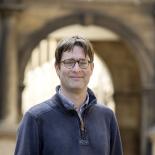Breadcrumb
Dr Christopher Lester
Dr Lester is an experimental high-energy particle physicist. His main research interest concerns the search for new physics at small scales - for example particles, symmetries, forces and extra space-time dimensions which are not yet part of the "Standard Model" of particle physics.
Dr Lester's work has been heavily tied to the construction, commissioning and exploitation of the "ATLAS Experiment" at CERN, the European Centre for Particle Physics in Geneva.
The ATLAS Experiment probe the states of matter that were present in the universe less than one picosecond after the "Big Bang". It accomplishes this with the help of the Large Hadron Collider, a 27km long circular particle accelerator circular tunnel on the Franco-Swiss border, which cow collides protons the highest centre-of-mass energies achieved anywhere in the world. In effect, the collisions produce tiny regions with the characteristics of small pieces of the big-bang. On its restart in 2015 after a two year shut down for refurbishments, the collider should about forty million collisions every second for a period of at least two years. If each part of the ATLAS detector continues to work as designed and is able to "photograph" or record the 0.001% of interesting collisions, then it should be possible to answer a number of presently open questions which are fundamental to particle physics. How many space time dimensions are there? Does supersymmetric matter exist? Is the Higgs Boson that was discovered in 2012 exactly the sort of Higgs Boson that features in the Standard Model, or is it something fancier? Can we make Dark Matter in the laboratory?
Experimentally, Dr Lester was involved in the commissioning of the Semi-Conductor Tracker - the part of the ATLAS detector second-closest to the interaction point. This device measures the momenta of charged particles, of which there will be hundreds in each event. When thinking about physics, he has been interested in understanding the mechanisms through which supersymmetric particles, perhaps including potential "Dark Matter" candidates (which may make up the majority of the universe, even though they have not been seen directly yet), may make themselves known to us in the data, given that half of their decay products could be invisible.
Senior Lecturer in Physics
A list of Dr Lester's publications may be found here.

